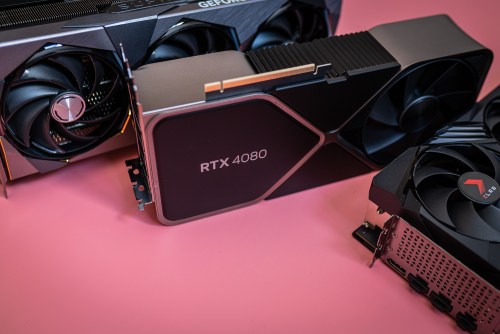
According to the latest round of leaks, Nvidia may be readying an RTX 4080 Ti, set to come out in the first few months of 2024. While such a GPU would definitely rank high among the best graphics cards, it’s not exactly necessary right now — there are plenty of high-end GPUs floating around. There is one reason I would like to see an RTX 4080 Ti, though; to push down the price of the RTX 4080.
MEGAsizeGPU, who is a frequent speculator in the graphics card space, shared over the weekend that an RTX 4080 Super, or maybe Ti, will come out in just a few months. Given Nvidia’s current naming convention in this generation, a Ti card seems more likely. As per MEGAsizeGPU, the card will be based on Nvidia’s flagship AD102 chip and will have a power consumption below 450 watts. The other specs are a mystery, but I wouldn’t be surprised if Nvidia added some more VRAM to the card — 20GB seems likely. The bump from AD103 to AD102 should also deliver a decent upgrade in CUDA core counts — dare I say in the 12,000 to 13,000 range?
While these specs sound good on paper, we really don’t need an RTX 4080 Ti (or RTX 4090 Ti, for that matter). The RTX 4080 is already pretty evenly matched against AMD’s top GPU, the RX 7900 XTX. While AMD’s card wins in rasterization, Nvidia’s RTX 4080 has access to DLSS 3, which gives it an edge if you care about it. Then, there’s the RTX 4090 that blows both cards out of the water.
We’ve covered on GPUs that cost over $1,000 for the generation. A stepping stone between the RTX 4080 and RTX 4090 doesn’t make much sense considering both cards are already outrageously expensive. We don’t need an RTX 4080 Ti, but I’m on board if it makes the base RTX 4080 drop below $1,000.
The leaker implies that the RTX 4080 Ti will be in a similar price range to the RTX 4080. If it’s priced at $1,200 from the get-go, it will basically be what the RTX 4080 should always have been — a premium card with high-end performance. As things stand now, the performance-to-price ratio for the RTX 4080 is among the worst we’ve seen in years.
When the RTX 4080 launched nearly a year ago, Nvidia’s outrageous pricing strategy reared its ugly head once again. A xx80 GPU priced at $1,200 was already problematic enough as it is, but to top it all off, it had significantly worse performance than the $1,600 RTX 4090. Moreover, its last-gen predecessor only cost $700 at launch.
Although I’m happy with my RTX 4080, I decided to get it while knowing that it’s one of the worst GPUs in terms of performance per dollar. My main regret is not saving up to get an RTX 4090 instead, as that card is actually more worth the money than the RTX 4080 — but that could change if an RTX 4080 Ti is released at a reasonable price.
If the RTX 4080 Ti steals the price tag of the RTX 4080, we’re bound to see some price cuts on the latter. You can already find some models of the card for around $1,050, and if the price officially drops to around $950 to $1,000, its value will automatically skyrocket. I’d love to see it go down to $900, but that might just be wishful thinking.
Will it actually happen? Will Nvidia adjust the price of the RTX 4080? I sure hope so. It’s not a bad card, it’s just a terrible value. And while we really don’t need the RTX 4080 Ti, if that’s what it takes for Nvidia to make the RTX 4080 more affordable, I’ll take it. We might end up with two GPUs with better value in the process.
Editors' Recommendations
- 5 cheap graphics cards you should buy instead of the RTX 4060
- Don’t buy the RTX 3060 in 2024
- You shouldn’t buy these Nvidia GPUs right now
- What is VSync, and why do you need it?
- Nvidia DLSS is amazing, but only if you use it the right way